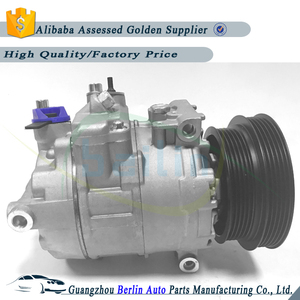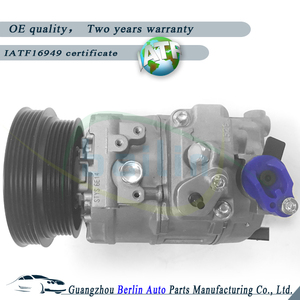(29 products available)












































































































































A car compressor 5n0820803a is a device used in vehicles to compress air or gas. It is mostly used in the car's air conditioning system. The 5n0820803a indicates the part number or model of the compressor. There are several types of car compressors, including:
Reciprocating Car Compressors
The car has a piston that moves up and down in a cylinder. When the piston moves down, it creates a vacuum that draws air into the cylinder. When the piston moves up, the air is compressed and pushed out of the cylinder. The cycle then repeats. Most car AC compressors are reciprocating compressors.
Rotary Vane Compressors
A rotor with sliding vanes is located inside a stator, which is an oval-shaped housing. As the rotor spins, the vanes slide in and out of the rotor, allowing them to move in and out of the rotor. This action creates expanding and contracting chambers that compress air as the rotor turns. The design of rotary vane compressors allows for a smooth flow of compressed air.
Scroll Car Compressors
Scroll compressors have two interleaved spiral-shaped elements. One spiral moves in an orbit within the other spiral. This motion draws in air and traps it in pockets between the spirals. The volume of these pockets decreases as the spirals move, compressing the air. Scroll compressors are recognized for their high efficiency and reliability.
Screw Compressors
Screw compressors have twin helical rotors. The male and female rotors move in opposite directions within a housing. As the rotors turn, the air is drawn into the inlet and trapped between the rotors and housing. The volume reduces as the rotors turn, compressing the air. Screw compressors are known for their constant flow and high efficiency.
Centafugal Compressors
Air is compressed by the rotational energy of an impeller in a radial housing. The impeller draws air in at the inlet and moves it outward through the rotating blades. As the air moves outward, it encounters a diffuser that decreases its velocity, converting kinetic energy into pressure. This process compresses the air in stages, allowing for efficient compression.
When it comes to specification, the car compressor 5n0820803a has a number of it.
Vehicle Compatibility:
Generally, a car compressor is compatible with various car models. This includes: Volkswagen, Audi, Seat, Skoda and many more.
Voltage Rating:
Car compressors have a standard voltage of 12 volts. This is the same as the car's electrical system. However, some models may require a different voltage rating. For example, a compressor for hybrid or electric vehicles.
Compressor Type:
There are different types of compressors. This includes: Reciprocating, rotary vane, scroll and screw compressors. Each type has its own working mechanism and advantages.
Cooling System:
Generally, a car compressor uses air as a cooling medium. However, some models use water especially for high-pressure compressors.
Maximum Pressure:
Car compressors have a maximum pressure of 6 to 10 bars. This is the pressure used to inflate tyres and other equipment.
Flow Rate:
Generally, the flow rate of a car compressor depends on the model and type. It ranges from 50 to 200 litres per minute. The flow rate affects how fast the compressor can fill air.
Noise Level:
Car compressors have a noise level of 60 to 80 decibels. This is the same as loud music or traffic. Some compressors are designed to be quieter.
Here are some tips on how to maintain the car compressor 5n0820803a.
Car owners with car compressor 5n0820803a know how important it is to have a well-functioning tire inflator. They won't have to worry about flat tires when driving. The only problem will be finding the right 5n0820803a air compressor for the vehicle. Here is how to do it:
It is always advisable to have an expert replace a car compressor. However, it is possible to DIY and replace the car compressor with the right skills and knowledge. Here are the steps to follow:
Step one
Locate the car compressor, which is usually found in the engine bay. It is also called the air-conditioning (A/C) compressor and is responsible for pumping refrigerant through the A/C system.
Step two
Ensure the A/C system is discharged to remove all refrigerants. This is important because it is illegal to release the refrigerant into the atmosphere, and it can also harm the environment. Only a licensed professional can do this.
Step three
Disconnect the negative battery cable and remove the electrical connections to the A/C compressor.
Step four
Remove the drive belt or serpentine belt that powers the A/C compressor.
Step five
Remove the bolts securing the compressor to the mounting hardware and carefully take out the car's compressor.
Step six
Install the new A/C compressor by first mounting it to the vehicle's engine and then tightening the bolts to secure it in place. The torque specifications for tightening the bolts can be found in the vehicle's service manual.
Step seven
Reattach the drive belt or serpentine belt to the A/C compressor.
Step eight
Reconnect the electrical connections to the A/C compressor and the positive battery cable.
Step nine
Have a professional vacuum the A/C system and charge it with refrigerant after ensuring that all the A/C lines and components are clean and free of debris and contamination.
Q1. How should the car compressor be handled to ensure safety?
A1. Read and follow the safety instructions in the user manual. Do not use the device when it is wet or in a wet environment. Make sure the power cord does not pose a trip hazard. Keep fingers and foreign objects away from the nozzle. Ensure the car compressor is on a stable surface before using it.
Q2. How do you know the Audi 5N0820803A tire compressor is working?
A2. When the Audi tire compressor is plugged into the power outlet, the indicator light will turn red. The tire pump will automatically stop when the set pressure is reached, and the indicator light will turn green. The vehicle's tire will be filled with air, and the tire compressor is working.
Q3. Can a car tire be inflated using a car tire compressor?
A3. Yes, a car tire compressor can inflate a fully flat low-pressure car tires. The process may take longer, and the compressor may overheat if used for long.
Q4. How long does it take to inflate a tire using a car tire compressor?
A4. The time will depend on the type of the tire compressor, its power and the tire size. Generally, a standard tire compressor will take 10 to 30 minutes to inflate a tire from 28 PSI to 36 PSI.